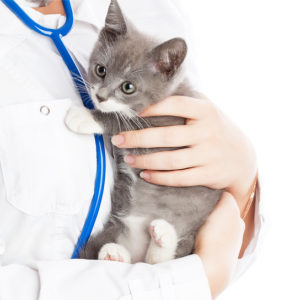When a person brings a pet into their household, they assume the responsibility of providing the animal with love and care – from food and water to daily exercise, regular veterinary checkups and preventive care, and most importantly, a safe place to call home. When illness or injury strikes, owners turn to veterinarians to guide them and their pets through a diagnosis and treatment plan tailored to their individual needs. More than 80,000 companion animal veterinarians across the country work tirelessly each day to provide exceptional care for America’s pets. Beyond that, veterinarians are responsible for the care of horses, farm animals, food supply animals, and wildlife.
The high standard of care veterinarians provide to these many species requires commitment, dedication, and years of rigorous education and training. However, the level of advanced training and education veterinarians have achieved may be a surprise to some pet owners.
Veterinarian education begins when they earn a science-based undergraduate degree, a four-year culmination of prerequisite studies focused on biology, organic chemistry, biochemistry, physics, microbiology, anatomy and physiology, and math. These are building blocks for the next phase of educational training.
Once admitted into veterinary school, students take rigorous and comprehensive courses in animal anatomy, physiology, pharmacology, microbiology, immunology, pathology, toxicology, biochemistry, and surgical techniques, as well as disease prevention, diagnosis and treatment, all underscored by in-depth courses on multiple animal species. Most programs structure the first three years of veterinary school with classroom, laboratory, and clinical work. A fourth year is dedicated to supervised clinical rotations within a veterinary medical practice or hospital. Graduation from an institution accredited by the AVMA Council on Education institution is a prerequisite for licensure or certification for professional practice through the majority of state licensing boards and credentialing agencies. Upon veterinary school graduation, students earn either a Doctor of Veterinary Medicine (DVM) or a Veterinary Medical Doctor (VMD) degree.
After graduation, students are required to take the North American Veterinary Licensing Examination (NAVLE), the most difficult test a veterinarian will have to pass, which is a requirement for licensure to practice. The national examination evaluates their mastery of veterinary science.
In order to actually practice veterinary medicine, a veterinarian must be licensed in the state where they intend to work. After passing the NAVLE, some states have added requirements, such as additional clinical competency tests and state regulatory exams. Veterinarians must also commit to the completion of ongoing education courses to retain their licenses each year.
The knowledge and education acquired through the successful completion of a doctorate in veterinary medicine qualifies veterinarians to accurately diagnose patients and maintain health standards with comprehensive treatment plans tailored to the individual animal. By the time a student graduates with a DVM or VMD degree, he or she is equipped with more expertise in animal care than any other medical professional. And yet, for most veterinarians, this education serves as the foundation for a career-long journey of continuous training and development.
Many veterinarians also seek supplemental experience through internships and residencies, often adding one to three years of training to achieve board certification in one of the 46 distinct AVMA-recognized veterinarian specialties such as oncology, anesthesiology, cardiology, neurology, or animal behavior.
Notably, unlike physicians, veterinarians are not just trained for one species. Their education and vigorous training not only address a wide range of species and different breeds but extend beyond individual animal care to herds, flocks, and entire animal populations.
This unparalleled expertise is why the AVMA and others agree that a qualified veterinarian-led team provides the best animal care. The successful completion of educational and training milestones in veterinary medicine enables these professionals to issue differential diagnoses accompanied by comprehensive diagnostic and treatment plans. That is why we do not support proposals to introduce a new mid-level position for our profession that would assume some of the veterinarian’s role. Someone without the same level of training as a veterinarian should not be making life-or-death decisions for your pet.
In rural, farm, and food production settings, creating a midlevel position could jeopardize not just the health and welfare of individual pets but also entire flocks and herds, creating risks to food safety, public health, animal movement, and even international trade. When a high-consequence disease emerges, having insufficiently educated and trained individuals on the frontline of diagnosis is dangerous. The result could be untold animal suffering, public health risks, food supply interruptions, and economic impact in the billions of dollars.
To protect the health and safety of animals, whether those animals are in urban, suburban, or rural areas, the actions of diagnosis, prognosis, prescribing drugs, and performing surgery must be preserved for those individuals who have completed years of formal education and training required to become a veterinarian. By leveraging this unique education and skill set, the veterinarian is well-positioned to lead a team of multi-dimensional veterinary professionals, including veterinary technicians, veterinary technologists, and veterinary technician specialists, to deliver the high-quality, holistic healthcare that every animal patient deserves.


